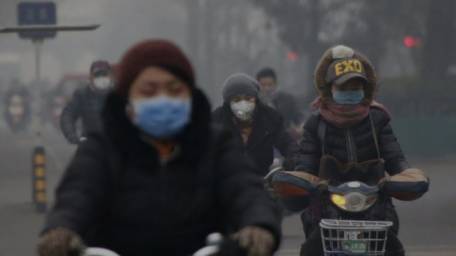Beijing’s red alert for smog requires a 3-day forecast
According to the BBC, Greenpeace had been campaigning since last week for the Chinese government to declare a red-alert, but the government instead issued an orange alert (the second-highest in their four-tier colour-coded system, adopted in 2013).
Last week, the city reported an orange alert, indicating a “very unhealthy” or “hazardous” level of pollution in the air and escalated the level to a red alert today, Monday, December 7th.
Auto use is being halved by allowing only odd or even numbered license plates on the road at one time and heavy vehicles including garbage trucks are banned from the streets. The alert requires a forecast of 72 straight hours with pollution levels of 300 or higher on the city’s air quality index.
The increasing severity of air pollution affecting Beijing has raised fresh concerns about the government’s ability tackle of bad air quality, despite the Chinese leadership’s prioritisation of cleaning up the country’s environment.
The smog will be dispersed by a cold wave next Thursday, the NMC said. Coal-fired electricity generation, as well as vehicle exhaust, are said to be the main factors driving up pollution levels across the region. Charcoal briquette-burning ovens that were once a major contributor to pollution are now much less common in Beijing, although they are still used widely in the countryside.
Half of all private cars have been taken off the capital’s roads, which led to the Metro trains becoming particularly crowded during the morning rush, state broadcaster CCTV reported.
Beijing’s Education Commission has chose to suspend classes in all elementary and middle schools, kindergartens and extracurricular training schools during the alert. Air + Style returned to Beijing’s Bird’s Nest for the first stop on the three-part tour, and other than the smog, the event was a huge success.
A user in Hebei, a city 150 km southwest of Beijing, said she felt like she was inhaling poison, and said she wanted to see a patch of blue skies again.
Beijing has pledged that emissions will peak “around 2030”, without saying at what level and implying several years of further increases.
Beijing authorities say that the air has been considerably cleaner this year than last.
Readings of PM2.5 – harmful microscopic particles that penetrate deep into the lungs – had hit 634 micrograms per cubic metre in Beijing on Dec 1, or more than 25 times above the safe limit set by the World Health Organisation. People have been asked to stay indoors and take preventive measures to protect themselves such as using a facemask and restricting the use of their vehicle, schools were ordered to close down and outdoor constructions have been stopped.
The country has tightened its emission standards and started making investment into renewable energy generation.
The red alert comes as Chinese government officials join their global counterparts in Paris for the UN Climate Summit.








